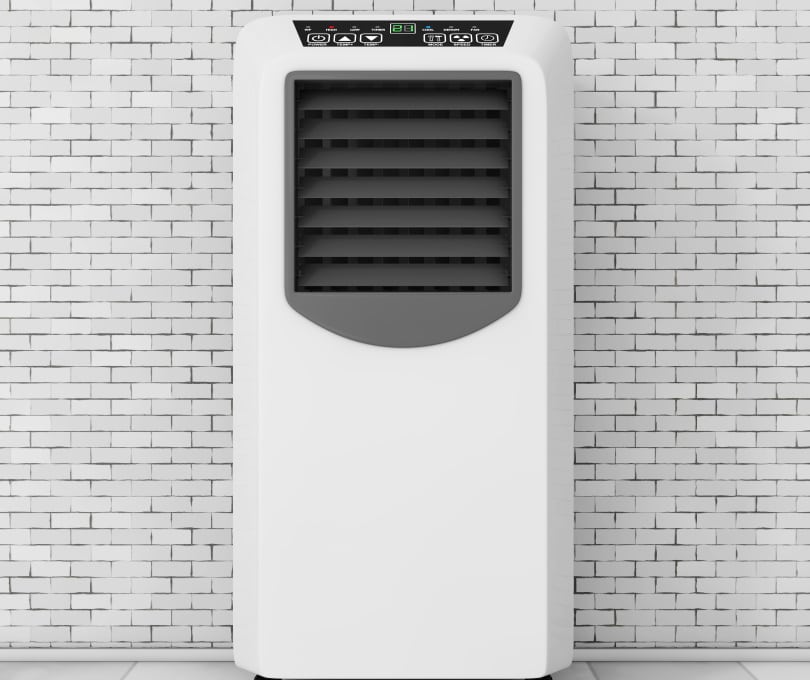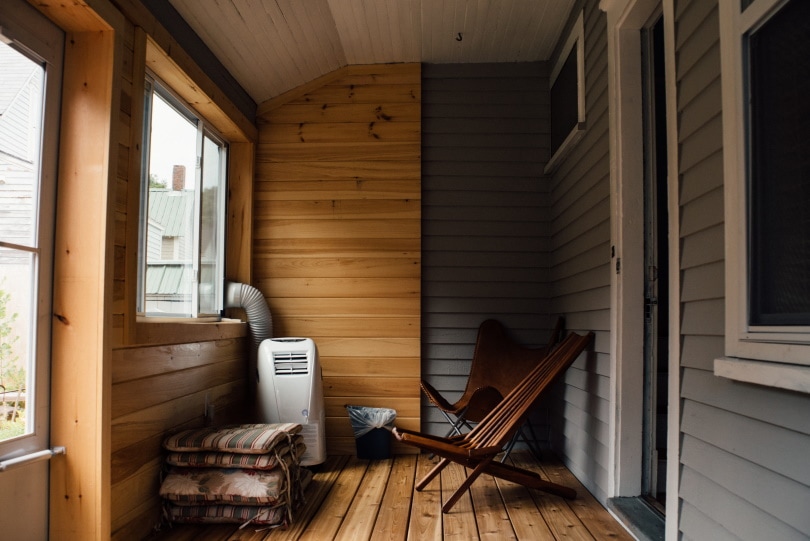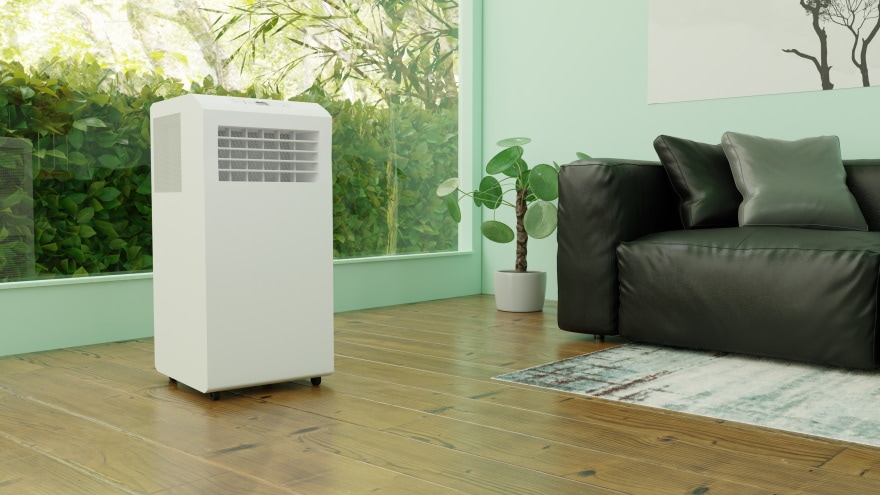How Do Portable Air Conditioners Work? (Advantages & Disadvantages)
-
Codee Chessher
- Last updated:

Air conditioners have become an essential part of the modern household, but there are numerous types designed for different situations. They all have their own quirks, too, like the portable air conditioner. You may know them as the ones that have hoses or ducts coming off a small, oftentimes rolling base unit.
If you’ve ever wondered how these machines work to reduce the humidity and regulate the temperatures of our homes, you’re at the right place. Let’s check out the answer to your questions and a lot of other relevant info about portable air conditioners.
How Do Portable Air Conditioners Work?
Sometimes called freestanding air conditioners, portable air conditioners are typically medium to large towers mounted on caster wheels. While central A/Cs use a series of ducts in your home and window air conditioners stick halfway out the window, portable air conditioners have a more straightforward way of venting hot air—a hose or duct comes off the back of the unit and runs outside a window.
Inside, they’re pretty similar to other air conditioners and contain most of the same component parts. Let’s briefly check those out and then see what they do in the portable air conditioner.
- Condenser coils
- Refrigerant
- Motor
- Compressor
- Fan
- Air duct
First, the motor-powered fan sucks in humid, hot air from your room and runs it across a series of copper condenser coils. These coils are filled with liquid refrigerant, which is pressurized by the compressor.
The phase change from liquid to gaseous form absorbs heat and moisture from its surroundings. It expands and runs through the condenser coils and back to the compressor, which turns it back into a liquid and starts the process anew. So, what about the air?
The air that passes over the coils is cooled and dried because of the heat and moisture being sucked away. This is the beloved blast of cool air we all love when we stand in front of an air conditioner’s vents. The hot air from the motor and your room is vented out the air duct leading from the back of the unit outside your window.
The air duct system isn’t terribly complicated, but newcomers to home appliance installation may be daunted by the idea of ductwork. Thankfully, new units typically come with the exhaust vent kit, including everything you need. These exhaust kits are pretty much the same thing that comes standard with any dryer, and installation is fairly easy.
A pretty big drawback is how portable air conditioners deal with the moisture collected. Some of it is evaporated through the heat exchange process, while the rest is collected in a water reservoir. The reservoir fills up just like the ones in dehumidifiers and needs to be periodically emptied. By contrast, other air conditioners take care of the moisture on their own.
Nicer portable air conditioners may come with the option to hook up a drain line or contain a self-evaporative system that literally evaporates away excess moisture. These features come with a correspondingly higher price tag than models with reservoirs. Upscale portable A/C units may also have the ability to heat, depending on the model.
The worst part about portable air conditioners is that they create negative air pressure in a room because they constantly draw air without replacing it. That means any tiny gap in your window or the room’s door will suck in hot air and make the unit less efficient. This drawback makes portable air conditioners more suited for small, well-sealed rooms or spot cooling. Double hose models nullify this problem somewhat but cost significantly more.
They simply lack the sheer cooling power of a ductless or central air conditioner, but portable units can roll and be relocated. The worst part of the process is removing the exhaust vent and reinstalling it.
What Are the Types of Portable Air Conditioners?
There are two types of portable air conditioners: single hose and double hose. They have their own set of benefits and drawbacks, so let’s briefly delve into those so you can better understand which type might be better for your home.
Single Hose
The most popular type of portable air conditioner, single hose models are easier and cheaper to install because they only require installing one vent. Single hose models are more inefficient at cooling overall.
Double Hose
Double hose portable air conditioners are more expensive and challenging to install because you have to install two vents in your window. One vents the hot air outside, while the other draws in fresh, cooler air into the machine. This makes it more efficient since it’s not just recycling the same air over and over.

What Are the Other Types of Air Conditioners?
It’s helpful to know a bit about the other types so you can have an idea of how they fare against portable units. These include:
- Window air conditioners: these are the gold standard for cost-effective A/Cs, and they’re preferable to portable units if you want to cool on a semi-permanent or permanent basis.
- Central air conditioners: the overall best A/C for a large home, central A/C requires extensive ductwork and installation but offers more powerful and precise heating and cooling.
- Ductless air conditioners: also called mini-splits, ductless A/Cs require professional installation but boast efficient cooling and heating over portable models.
Where Are Portable Air Conditioners Used?
Portable air conditioners are a great choice for well-sealed rooms and to provide supplementary cooling for larger spaces, but their BTU (British thermal unit) rating determines their raw cooling power. As a rule of thumb, 8,000 BTU is sufficient for a 200-square-foot room, while 10,000 is enough for a 300-square-foot room. Above that, every 2,000 BTU per roughly 100 additional square feet is how the scale expands.
You can use a portable A/C for nearly any space considering their wheeled design, which makes them more convenient to relocate and install. Portable units are more efficient than a window A/C, but not nearly as energy efficient as a ductless air conditioner. As a result, you may see higher power bills when using a portable unit for cooling.

Advantages of Portable Air Conditioners
- Don’t require professional installation, which cuts on initial costs vs. other air conditioners
- Fairly simple to relocate, which makes them versatile for supplementary cooling during sweltering, sticky summer heat waves
- Modern dehumidifier-like look helps them blend in nearly anywhere
- Several models available for different situations
- Some models offer heating capability
Disadvantages of Portable Air Conditioners
- Less efficient at cooling than other air conditioners, which means higher power bills for you
- Because they’re physically in the room, portable A/Cs are quite loud and noticeable
- May need to empty water reservoir often in very humid climates
- Single hose units recycle the same air over and over, which becomes apparent after a while with stale air quality
- Obstructs a window
Frequently Asked Questions (FAQs) About Portable Air Conditioners
- When Should I Use a Portable Air Conditioner?
We can’t in good conscience recommend portable air conditioners as a primary cooling system because they’re so inefficient compared to other types of A/C units. They’re great, on the other hand, for small bedrooms, home offices, workshops, man (or woman) caves, etc.
- How Can I Make a Portable Air Conditioner More Efficient?
There are several ways you can make portable air conditioners more efficient at cooling spaces and potentially lower their impact on your electricity bill. Let’s check some of those out below.
- Add insulation to the room if possible
- Make absolutely certain the exhaust vent kit is installed correctly because minute air gaps can have a huge impact on the unit’s efficiency
- Seal door and window gaps in the room to maximize efficiency
- To reduce strain on the portable A/C and save a smidge of power, turn it on in the cooler early morning or late evening hours
- Avoid putting portable air conditioners in rooms that are too large, as they become more inefficient in larger spaces
- Consider a double hose model to help introduce fresh air from outside
- What’s the Best Way to Drain Portable Air Conditioners?
There are three main ways portable A/C units dispose of water from the cooling process: self-evaporative, water reservoirs, and drain hoses.
Self-evaporative systems are pricier but dispose of water without hoses, whereas drain hoses take some installation. Units with reservoirs are the more annoying to deal with but require no installation or upcharge.
Conclusion
Portable air conditioners are an awesome way to cool smaller rooms and their wheels make them easy to install, but they have several notable caveats you should know about. Namely, their relative inefficiency compared to other types of A/Cs, plus the amount of work that goes into making them efficient can somewhat void the portability aspect.
Featured Image Credit: doomu, Shutterstock
Contents

